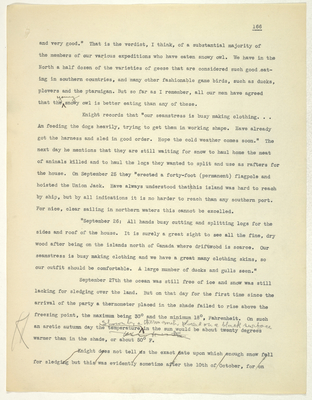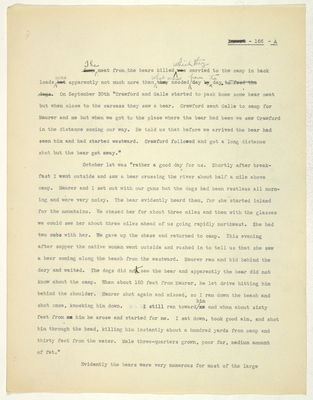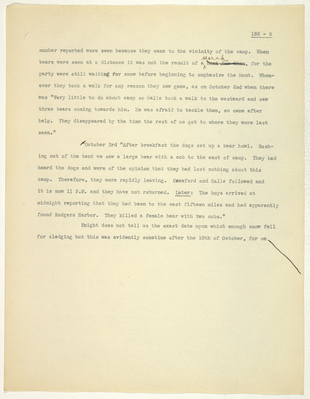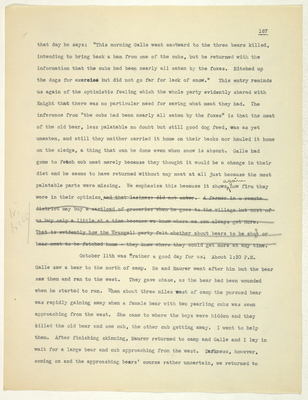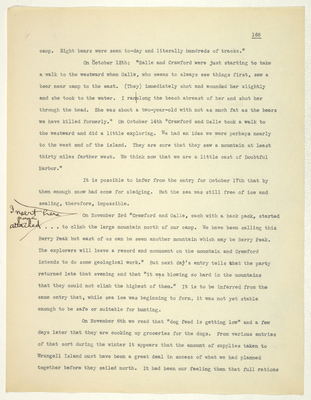Pages
stefansson-wrangel-09-29-011
166
and very good." That is the verdict, I think, of a substantial majority of the members of our various expeditions who have eaten snowy owl. We have in the North a half dozen of the varieties of geese that are considered such good eating in southern countries, and many other fashionable game birds, such as ducks, plovers and the ptarmigan. But so far as I remember, all our men have agreed that the young snowy owl is better eating than any of these.
Knight records that “our seamstress is busy making clothing. . . Am feeding the dogs heavily, trying to get them in working shape. Have already got the harness and sled in good order. Hope the cold weather comes soon." The next day he mentions that they are still waiting for snow to haul home the meat of animals killed and to haul the logs they wanted to split and use as rafters for the house. On September 25 they “erected a forty-foot (permanent) flagpole and hoisted the Union Jack. Have always understood thatthis island was hard to reach by ship, but by all indications it is no harder to reach than any southern port. For nice, clear sailing in northern waters this cannot be excelled.
"September 26: All hands busy cutting and splitting logs for the sides and roof of the house. It is surely a great sight to see all the fine, dry wood after being on the islands north of Canada where driftwood is scarce. Our seamstress is busy making clothing and we have a great many clothing skins, so our outfit should be comfortable. A large number of ducks and gulls seen."
September 27th the ocean was still free of ice and snow was still lacking for sledging over the land. But on that day for the first time since the arrival of the party a thermometer placed in the shade failed to rise above the freezing point, the maximum being 30° and the minimum 18°, Fahrenheit. On such an arctic autumn day the temperatre shown by a thermameter placed on a black surface in the sun would be about twenty degrees warmer than in the shade, or about 50° F.
Knight does not tell us the exact date upon which enough snow fell for sledging but this was evidently sometime after the 10th of October, for on
stefansson-wrangel-09-29-012
- 166 - A
Some The meat from the bears killed was which they carried to the camp in back loads but was apparently not much more than they what was needed from day by to day. to feed the dogs. On September 30th "Crawford and Galle started to pack home some bear meat but when close to the carcass they saw a bear. Crawford sent Galle to camp for Maurer and me but when we got to the place where the bear had been we saw Crawford in the distance coming our way. He told us that before we arrived the bear had seen him and had started westward. Crawford followed and got a long distance shot but the bear got away."
October 1st was "rather a good day for us. Shortly after breakfast I went outside and saw a bear crossing the river about half a mile above camp. Maurer and I set out with our guns but the dogs had been restless all morning and were very noisy. The bear evidently heard them, for she started inland for the mountains. We chased her for about three miles and then with the glasses we could see her about three miles ahead of us going rapidly northwest. She had two cubs with her. We gave up the chase and returned to camp. This evening after supper the native woman went outside and rushed in to tell us that she saw a bear coming along the beach from the westward. Maurer ran and hid behind the dory and waited. The dogs did not see the bear and apparently the bear did not know about the camp. When about 150 feet from Maurer, he let drive hitting him behind the shoulder. Maurer shot again and missed, so I ran down the beach and shot once, knocking him down. I still ran toward/himxe and when about sixty feet from xe him he arose and started for me. I sat down, took good aim, and shot him through the head, killing him instantly about a hundred yards from camp and thirty feet from the water. Male three-quarters grown, poor fur, medium amount of fat."
Evidently the bears were very numerous for most of the large
stefansson-wrangel-09-29-013
166 - B
number reported were seen because they came to the vicinity of the camp. When bears were seen at a distance it was not the result of a search, for the party were still waiting for snow before beginning to emphasize the hunt. Whenever they took a walk for any reason they saw game, as on October 2nd when there was "Very little to do about camp so Galle took a walk to the westward and saw three bears coming towards him. He was afraid to tackle them, so came after help. They disappeared by the time the rest of us got to where they were last seen."
October 3rd "After breakfast the dogs set up a bear howl. Rushing out of the tent we saw a large bear with a cub to the east of camp. They had heard the dogs and were of the opinion that they had lost nothing about this camp. Therefore, they were rapidly leaving. Crawford and Galle followed and it is now 11 P.M. and they have not returned. Later: The boys arrived at midnight reporting that they had been to the east fifteen miles and had apparently found Rodgers Harbor. They killed a female bear with two cubs."
Knight does not tell us the exact date upon which enough snow fell for sledging but this was evidently sometime after the 10th of October, for on
stefansson-wrangel-09-29-014
167
that day he says: "This morning Galle went eastward to the three bears killed, intending to bring back a ham from one of the cubs, but he returned with the information that the cubs had been nearly all eaten by the foxes. Hitched up the dogs for exercise but did not go far for lack of snow." This entry reminds us again of the optimistic feeling which the whole party evidently shared with Knight that there was no particular need for saving what meat they had. The inference from "the cubs had been nearly all eaten by the foxes" is that the meat of the old bear, less palatable no doubt but still good dog feed, was as yet uneaten, and still they neither carried it home on their backs nor hauled it home on the sledge, a thing that can be done even when snow is absent. Galle had gome to fetch cub meat merely because they thought it would be a change in their diet and he seems to have returned without any meat at all just because the most palatable parts were missing. We emphasize this because it shows again how firm they were in their optimism. and thea laziness did not enter. A farmer in a remote district may buy a cartload of groceries when he goes to the village but most of us buy only a little at a time because we know where we can always get more. That is evidently how the Wrangell party felt whether about bears to be shoot or bear meat to be fetched home - they knew where they could get more at any time.
October 11th was "rather a good day for us. About 1:30 P.M. Galle saw a bear to the north of camp. He and Maurer went after him but the bear saw them and ran to the west. They gave chase, as the bear had been wounded when he started to run. When about three miles west of camp the pursued bear was rapidly gaining away when a female bear with two yearling cubs was seen approaching from the west. She came to where the boys were hidden and they killed the old bear and one cub, the other cub getting away. I went to help them. After finishing skinning, Maurer returned to camp and Galle and I lay in wait for a large bear and cub approaching from the west. Darkness, however, coming on and the approaching bears’ course rather uncertain, returned to
stefansson-wrangel-09-29-015
168
camp. Eight bears were seen to-day and literally hundreds of tracks."
On bctober 13th; "Galle and Crawford were just starting to take a walk to the westward when Galle, who seems to always see things first, saw a bear near camp to the east. (They) immediately shot and wounded her slightly and she took to the water. I ranalong the beach abreast of her and shot her through the head. She was about a two-year-old with not as much fat as the bears we have killed formerly." On October 14th "Crawford and Galle took a walk to the westward and did a little exploring. We had an idea we were perhaps nearly to the west end of the island. They are sure that they saw a mountain at least thirty miles farther west. We think now that we are a little east of Doubtful Harbor."
It is possible to infer from the entry for October 17th that by then enough snow had come for sledging. But the sea was still free of ice and sealing, therefore, impossible.
Insert here page attached
On November 3rd "Crawford and Galle, each with a back pack, started ... to climb the large mountain north of our camp. We have been calling this Berry Peak but east of us can be seen another mountain which may be Berry Peak. The explorers will leave a record and monument on the mountain and Crawford intends to do some geological work." But next day’s entry tells that the party returned late that evening and that "it was blowing so hard in the mountains that they could not climb the highest of them." It is to be inferred from the same entry that, while sea ice was beginning to form, it was not yet stable enough to be safe or suitable for hunting.
On November 6th we read that "dog feed is getting low" and a few days later that they are cooking up groceries for the dogs. From various entries of that sort during the winter it appears that the amount of supplies taken to Wrangell Island must have been a great deal in excess of what we had planned together before they sailed north. It had been our feeling then that full rations
